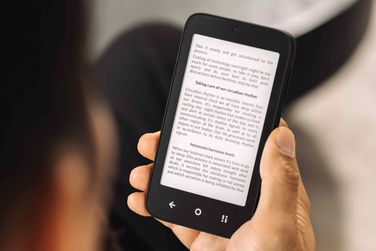The Mudita Kompakt runs Android but only includes a small collection of essential apps so it’s less of a distraction.
Share this story
Mudita is not the first company to build a phone with an E Ink screen, but its Kompakt isn’t only about bringing the benefits of e-paper to smartphones. The company describes the Kompakt as a “minimalist E Ink phone” that’s designed to reduce distractions with a limited collection of bundled apps.
The Kompakt is being made available to consumers through a Kickstarter crowdfunding campaign. The earliest backers can pre-order one for around $325 with shipping expected as early as April 2025. Full retail pricing is expected to be closer to $476, making the Kompakt cheaper than other E Ink phones from companies like Hisense.
Unlike the Boox Palma, which is a pocket-friendly 6.13-inch e-reader offering additional functionality through a full implementation of Android, the Kompakt features a much smaller 4.3-inch E Ink screen with a resolution of just 800×480 pixels and a stripped down operating system.
The Kompakt runs MuditaOS K, a custom operating system based on the Android Open Source Project. It skips all of Google’s services to ensure your “data is never shared or monetized by third parties” and only has a small assortment of preinstalled apps the company has deemed essential. These include a phone app with SMS messaging, offline maps, a voice recorder, a calculator, a photo-only camera (limited to 8MP), and an e-reader supporting ePubs and PDFs. The OS doesn’t include access to the Google Play Store, and while other Android apps can be sideloaded, according to New Atlas, full compatibility and performance isn’t guaranteed.


Crowdfunding is a chaotic field by nature. Companies looking for funding tend to make big promises. According to a study run by Kickstarter, roughly 1 in 10 “successful” products that reach their funding goals fail to actually deliver rewards. Of the ones that deliver, delays, missed deadlines, or overpromised ideas mean that there’s often disappointment in store for those products that do get done.
The best defense is to use your best judgment. Ask yourself: does the product look legitimate? Is the company making outlandish claims? Is there a working prototype? Does the company mention existing plans to manufacture and ship finished products? Has it completed a Kickstarter before? And remember, you’re not necessarily buying a product when you back it on a crowdfunding site.
To occasionally make the phone even less of a distraction, or to enhance its privacy, the Kompakt has a software option to disable its camera, Bluetooth, and Wi-Fi. On the side of the phone is also a sliding switch that activates a “hardware-level cutoff of GSM and all three microphones,” although Mudita doesn’t explain exactly how it works, or to what extent those functions are disabled.
Other features of the Kompakt include a 3,300mAh battery the company says will provide up to six days of standby time, an IP54-rating, a 3.5mm headphone jack, a fingerprint reader, NFC, wireless charging, and a dual SIM tray that can also accept a microSD card to expand its 32GB of storage.
Two versions of the Kompakt will be available that are optimized for either North American or global cellular networks, but the tiny phone skips 5G connectivity entirely. Although that will further discourage using it to access distractions like social media, access to 2G, 3G, and 4G LTE networks could also hinder its connectivity in some places.



